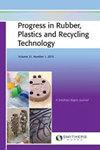Comparative study: High performance polymers of polyphenylene sulfide and polyethylenimine using Taguchi-Topsis optimization approaches
IF 1.6
4区 材料科学
Q4 MATERIALS SCIENCE, COMPOSITES
Progress in Rubber Plastics and Recycling Technology
Pub Date : 2024-09-10
DOI:10.1177/14777606241281611
引用次数: 0
Abstract
The role of high-performance thermoplastic products is increasing in the present days because of its excellent physical and mechanical properties and also capable of withstanding critical loads and temperatures. In this study, an attempt was made to improve the mechanical and physical properties of two polymers PPS (Polyphenylene Sulfide) and PEI (Polyethylenimine) by addition of glass fiber as a reinforcement fiber. The glass fiber (GF) content considered as 40 wt% for both the polymers. Injection molding method was used for fabrication of PPS and PEI samples. After fabrication, mechanical tests such as tensile, impact and dimensional shrinkage (%) of samples were calculated. Taguchi and Topsis analysis techniques were applied for evaluation of major influencing parameters and determining the best experiment to be performed on the machine. After conducting the test, PPS polymer exhibited better mechanical strength values and lower shrinkage (%) compared to PEI. The best input parameters kept on the machine were observed to be gate way type, temperature and pressure. The conditions of gate way type 2, temperature 320°C, and a pressure of 100 bar are obtained as the best input parameters to be fixed on the machine for achieving higher values of mechanical strength and lower dimensional shrinkage for both PPS and PEI polymers. Out of these two polymers, PPS exhibited better mechanical and physical properties combining with GF. This polymer can extend its usage as a high-performance polymer for various industrial applications.比较研究:采用 Taguchi-Topsis 优化方法研究聚苯硫醚和聚乙烯亚胺的高性能聚合物
由于高性能热塑性产品具有优异的物理和机械性能,并且能够承受临界载荷和温度,因此其作用与日俱增。本研究尝试通过添加玻璃纤维作为增强纤维来改善 PPS(聚苯硫醚)和 PEI(聚乙烯亚胺)这两种聚合物的机械和物理特性。两种聚合物的玻璃纤维(GF)含量均为 40 wt%。PPS 和 PEI 样品的制造采用注塑成型法。制作完成后,对样品进行拉伸、冲击和尺寸收缩率(%)等力学测试。应用田口分析和 Topsis 分析技术评估主要影响参数,并确定在机器上进行的最佳实验。试验结果表明,与 PEI 相比,PPS 聚合物的机械强度更高,收缩率(%)更低。据观察,机器上的最佳输入参数是浇口类型、温度和压力。闸道类型 2、温度 320°C、压力 100 巴是固定在机器上的最佳输入参数,可使 PPS 和 PEI 聚合物获得更高的机械强度值和更低的尺寸收缩率。在这两种聚合物中,PPS 与 GF 结合后表现出更好的机械和物理性能。这种聚合物可作为高性能聚合物广泛应用于各种工业领域。
本文章由计算机程序翻译,如有差异,请以英文原文为准。
求助全文
约1分钟内获得全文
求助全文
来源期刊

Progress in Rubber Plastics and Recycling Technology
MATERIALS SCIENCE, COMPOSITES-POLYMER SCIENCE
CiteScore
4.40
自引率
7.70%
发文量
18
审稿时长
>12 weeks
期刊介绍:
The journal aims to bridge the gap between research and development and the practical and commercial applications of polymers in a wide range of uses. Current developments and likely future trends are reviewed across key areas of the polymer industry, together with existing and potential opportunities for the innovative use of plastic and rubber products.
 求助内容:
求助内容: 应助结果提醒方式:
应助结果提醒方式:


